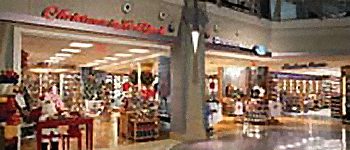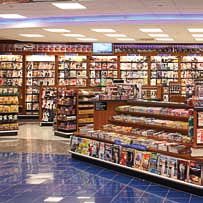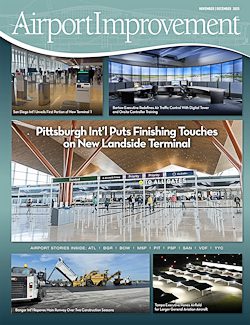At 7,000 square feet, the Hudson Group’s shops in Terminal 4 at John F. Kennedy International Airport were already the company’s largest contiguous retail space. Hudson, however, wanted them to be its design-leaders as well. So the company completely renovated them – even though the stores were barely three years old.
“We wanted to deliver a ‘wow’ shopping experience and create a magnificent gateway to the great metropolis of New York City,” explains Laura Samuels, director of corporate communications. “We also wanted to bring back the opulence of the early days of luxury travel.”

Designers at TranSystems provided the Big Apple flair by adding New York street scenes, cityscapes and vignettes of a residential loft to the store walls. Architects denoted opulence with backlit glass, wood-veneer floors, brass detailing and granite and stone fixture accents. With the completed stores serving nearly 40,000 customers weekly, durability was also a key factor in material selection.
After six months of drawing and permit reviews, construction was concentrated into 13 briskly paced weeks. During renovations, Hudson set up a larger-than-usual temporary store just outside the construction barricades. Mobile cash registers and specially designed merchandising units called waterfalls allowed employees to completely close up the shop each night.
A Private Affair
Terminal 4 is a unique environment for Hudson and 18 other retail stores. With 9 million annual passengers, the 165-acre terminal rivals many midsize airports in passenger traffic. But that’s not all that makes it different. Terminal 4 at JFK is the only major international terminal in the United States run by a private management company rather than a governmental or airline agency.
|
|
In the early ’90s, the airport issued a request for proposal to build, operate, develop and manage a new terminal to replace its aging International Arrivals Building. Three companies – real estate developer LCOR, investment bankers Lehman Brothers and Schiphol USA, an affiliate of Amsterdam Schiphol Airport – joined forces and won the business in 1997. The resulting consortium, JFK International Air Terminal LLC (JFK IAT), managed the $1.4 billion redevelopment project and has operated the terminal ever since.
“It’s a unique business model here, but it’s more common for European airports,” explains Janice Holden, JFK IAT’s chief commercial officer.
During store renovations, JFK IAT acted as an intermediary between Hudson and the Port Authority of New York and New Jersey, which owns the airport. “They reviewed our drawings and coordinated with the base building before we submitted for permitting,” explains architect Rosi Rawson. “The process allows for less ‘surprise’ in the field.”
Ongoing facility maintenance is another prime aspect of the relationship.
“In addition to our own renowned obsession with maintenance, JFK IAT keeps a close eye on things,” says Samuels.
“We have a director of commercial operations who sees every speck of dust,” notes Holden. “When retail space looks good, it sells more, and everybody wins. We work as partners.”
Location, Location, Location
Many airport retailers would cringe at pre-security spots like those occupied by the four renovated stores – Hudson News, Discover New York, Hudson Booksellers and Christmas in New York. At Terminal 4, however, the disadvantages seem minimal.
“We opened the terminal in 2001, just four months prior to 9/11,” notes Holden. “It was built like an elegant European rail station, with the food, services and retail concentrated before the boarding areas. Clearing security checkpoints wasn’t nearly the issue it is today.”
Despite an industry-wide paradigm shift that followed the 9/11 attacks, business at the 100,000-square-foot retail mall is strong – roughly $110 million last year. Holden attributes much of the business to the relatively weak U.S. dollar.
 “We get planeloads of tourists who come to shop in New York just before Thanksgiving,” she explains. “With the exchange rate, merchandise is essentially half-price for British shoppers. They spend thousands of dollars, and they often continue buying at the airport on their way home.”
“We get planeloads of tourists who come to shop in New York just before Thanksgiving,” she explains. “With the exchange rate, merchandise is essentially half-price for British shoppers. They spend thousands of dollars, and they often continue buying at the airport on their way home.”
In addition, 17% of outgoing passengers bring friends and family with them to the terminal – thousands of potential bonus customers for retailers and other concessionaires.
When Hudson re-opened its newly renovated four stores in July 2006, business jumped 30% over similar periods the year before.
Dwell time is notably high in Terminal 4: 165 minutes last year; 221 minutes this year. “Dwell times like that are usually unheard of,” stresses Holden. “Having a high percentage of international travelers (80%) and being largely an origination and destination airport helps, but we are getting more connecting passengers.”
Plenty of repeat passengers – fully 40% – may also help increase dwell times. “They’ve been here before, so they know we have great shopping,” Holden speculates.
Keep ’em Moving
Having stores located before the security gates presents unique challenges.
The 45 airlines that operate in the terminal want to get passengers through security and to their gates well before departure. Retailers, however, want passengers to browse as long as possible.
JFK IAT, which serves both constituents, reconciles the opposing views by helping move passengers through security quickly and efficiently. “We spend a lot of time and effort making sure traffic keeps moving,” explains Holden. “Before every shift, we brief the TSA about how many passengers to expect, where they’re coming from and whether they’ll have a lot of carry-on baggage.”
Lines at checkpoints are monitored via video cameras, and JFK IAT dispatches its own staff to help remedy buildups.
“Obviously, we don’t do any screening,” she clarifies. “But acting as traffic cops – directing passengers and helping sort them to the proper areas – helps a lot.”
A consortium of airlines operating at the terminal also lends a hand by hiring staff to monitor the process prior to reaching the document checkers.
For Hudson, the pre-security dynamic affects architecture and staffing. Multiple cash registers are offered at each counter to accommodate passengers rushing to catch flights. Books and magazines are also repeated throughout the store to expedite the search for a particular title.
“We train our sales associates in the fine art of determining the difference between the hurried traveler and the more leisurely shopper ‘killing time’ during a long layover,” adds Samuels. “They are very adept at discerning when to proceed quickly to the sale and when to offer assistance, provide background information on products and otherwise engage the customer.”![]()



